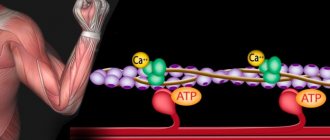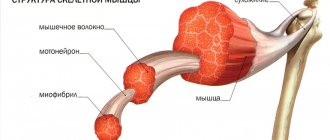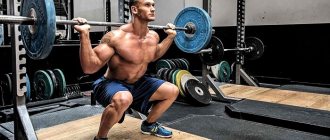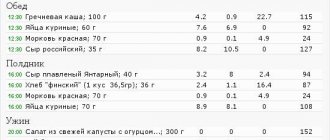How to gain lean muscle mass without fat and become bigger? The answer is very simple - you need to train hard for a long time and follow special nutrition rules. To build a beautiful and sculpted figure, you do not need to use a variety of pharmacological drugs - you need to follow a diet and give the body rest after intense exercise.
If a person is underweight or does not have excess fat, then while gaining muscle mass you need to be prepared to gain fat. By increasing your daily calorie intake (which is what you need to do if you need to gain weight), not only muscle, but also fat will grow.
Interesting! Each new kilogram of muscle mass adds 0.25 kilograms of fat.
Weight gain and excess fat, despite a combination of strength and cardio training, should not be feared. After dialing, you should dry out, then the fat will go away and an attractive body shape will remain.
Nutrition for gaining lean muscle mass
Squirrels
It has been scientifically proven that the daily protein requirement for humans is 1 g. At the same time, scientists also prove that large amounts of the substance are harmful to the kidneys and the body as a whole. But still, many professionals are inclined to the theory that there should be a lot of protein. And so, indeed, by consuming 1 g of protein, muscles will not be destroyed, but provided that a sufficient amount of carbohydrates is consumed. In order for muscles to grow, it is necessary not only to provide the daily requirement for a normal person, but also to take into account that an athlete needs twice as many amino acids in order for new tissue to form.
Thus, for an athlete, 2 g of protein per 1 kg of body weight is sufficient.
1 g of pure protein contains 4 calories, the same as carbohydrates. But the difference between them is huge. The advantage of protein is that its excess does not turn into fat, but with carbohydrates the picture is different.
Carbohydrates
It is carbohydrates that provide the athlete with energy for productive training; a lack of energy will not allow one to exercise at full strength, which means that the muscles will not receive the necessary damage for further growth. Carbohydrates are divided into two types: slow and fast - based on the speed of absorption, or complex and simple - based on composition.
- Slow (complex) carbohydrates are able to release energy over a long period of time, which is necessary when training for weight. Solid fibers of such substances take longer to digest and reduce the feeling of hunger for a long time. Accordingly, muscle breakdown during production of hard fibers is minimized. Fiber-rich foods – cereals and grains, vegetables. To gain mass but without fat, consume 2.5-3 g of complex carbohydrates per 1 kg of body weight. But know that consuming even the longest-lasting cereals in the evening also leads to excess energy and storage in the fat depot. Save carbohydrates for lunch and post-workout meals , not forgetting the importance of carbohydrate loading.
- As for fast (simple) ones , their ability to cause a release of insulin in the blood due to the high level of sugar in the composition (glucose, galactose, fructose, lactose) provides short-term but quick energy. This type includes the following products: confectionery, flour products, fruits, starchy vegetables, sugar, honey and other sweets. This composition can cause the accumulation of excess fat, which means that such products are contraindicated for gaining lean muscle mass.
Fats
They are necessary for weight growth, like other substances. Avoid heavy animal fats and refined oils. Healthy fatty acids are found in fish, nuts, and cold-pressed oils. For lean mass, the amount of 1 g of fat per 1 kg of weight will not harm. Omega-3 complex can be found in sports nutrition supplements.
Tips for gaining lean muscle
Double your portions A person gaining lean mass should eat a lot. For example, you can safely increase portions of foods containing protein by 2 or even 3 times.
Eating food on time It is important not only to eat more, but also to do it on time. The optimal number of meals is 5-6 times a day, without leaving more than 3 hours between them.
Do not neglect nutrition after training As a result of training, a person consumes proteins, carbohydrates and fats. Therefore, it is definitely worth eating after a workout - this will allow you to quickly recover from a workout and also lead to muscle growth. If you have done a lot of strength training, a portion of protein will allow you to both restore strength and build muscle tissue.
Consume high-calorie foods Diet for gaining lean mass must include high-calorie foods, because one of the basics of pumping up muscles is consuming more calories than the body burns. The best sources of calories are porridge (buckwheat, oatmeal, brown rice), meat and fish. Be sure to include cottage cheese and hard cheese in your diet.
1g of carbohydrates and proteins contains 4 kcal, and 1g of fat contains approximately 10 kcal. However, this is not a reason to get carried away with the latter: in percentage terms, the correct diet looks something like this - 50% complex (slow) carbohydrates, 40% proteins and 10% fats. Track your calorie intake
How to gain lean mass without fat? Accurately counting the calories you consume is guaranteed to protect you from gaining excess fat. But first you need to determine your basal metabolism (calorie intake to maintain weight), which is individual for each person. Using a calculator, you can calculate your norm using the formula in the table.
Men 66 + (13.7 x body weight) + (5 x height in cm) – (6.8 x age)
Women 655 + (9.6 x body weight) + (1.8 x height in cm) – (4.7 x age)
Then the result must be multiplied by a coefficient characteristic of your level of physical activity:
1.2 – mostly sedentary lifestyle;
1.375 - average activity, corresponds to 2-3 light physical activities per week.
1.55 – high activity, with 3-5 intense sessions per week.
1.725 - very high activity, heavy training 6 to 7 times a week.
As a result, you will get the number of calories needed to maintain your weight. To gain weight, this number must be gradually increased.
Add some cardio training
Gaining weight without cardio training can lead to problems with the cardiovascular system. Why? When you build muscle mass, the volume of blood in your body increases, and since your heart has to pump it, it experiences increased stress. In order for the heart to cope with increased load, it must train and, accordingly, increase in volume.
An additional advantage of cardio is that it helps burn excess fat and speeds up metabolism. They also won't take much time - just 10-15 minutes on the treadmill at the beginning and end of the workout will be enough.
Never exercise on an empty stomach
Without sufficient energy reserves, training will be short and ineffective. The only source of energy is food, so before going to the gym, a small snack is a must. In addition, when exercising on an empty stomach, metabolism can decrease and even muscle mass can be lost.
Sports nutrition for gaining lean mass
- Whey protein (isolate) is a purified supplement, has virtually no sugar, and 2 servings per day will replace meals and replenish with quality protein after muscle breakdown during exercise. Read more about whey protein →
- Amino acids are builders of new muscles. The growth of dry mass is impossible without amino acids, especially BCAA, which are not produced by the body. You need two servings of BCAAs per day, one serving on an empty stomach, the second immediately after training. Full cycle amino acids also 2 servings, one before training 30 minutes, the second at night.
How to train properly while gaining muscle mass?
You will have to train hard and a lot. But don't overdo it. You should keep it to no more than 60-95 minutes. If you spend more than two hours in the gym, the possibility of overloading the body increases. You simply won't have time to recover. Therefore, try to keep it within an hour and a half.
You should approach the very construction of a training plan very seriously and figure out how to correctly draw up a training program, what exercises the training should consist of, what the rest period should be, and so on.
To gain muscle mass, it is recommended to pay more attention to strength training, that is, performing, for the most part, basic exercises with a minimum of aerobic exercises. Although, of course, the aerobic part must be present. In general, pay attention to the bench press, various basic back exercises, for example: bent-over rows, pull-ups, etc. Also, squats with a barbell. This is a very important exercise that will not only build muscle in the legs, but also increase the secretion of the male hormone - testosterone. This is the most important androgen that will provide you with increased strength and muscle mass.
conclusions
Do not forget that all people are different, and one method of nutrition and training cannot be applied to everyone. But more often, endomorphs are capable of gaining muscle and large amounts of fat, since this type of constitution has a slow metabolism. The rest are mesomorphs, especially ectomorphs, who gain lean muscles without much difficulty, nature helps them with this. Although, with an unbalanced diet, all types experience difficulties, either there is too much fat, or muscles do not grow. Therefore, maintain a balance of nutrients , exercise intensively and regularly. If you see a little fat gain, add cardio.
The use of steroids when gaining muscle mass
In general, pharmacological drugs were originally intended for medical use. However, athletes, for whom such benefits from the use of steroids are vital to achieve athletic heights, could not help but notice the undoubted benefits for the body in terms of increased strength, endurance and muscle mass growth. What am I talking about, you ask me. Moreover, the use of pharmacology always implies achieving heights in professional sports, where athletes live by it and receive money for this whole business. So, unless you are a professional bodybuilder, it is better not to touch steroids. However, if you still want to go to the dark side, it is better to do this from the age of 21 and 1-2 years of experience in the gym.
When gaining muscle mass, a wide variety of drugs are used, for example: turinabol, Sustanol-250, trenbolone, methandienone, Omnadren-250 (an analogue of Sustanon), etc. In fact, there are a lot of drugs and each one affects the body differently. Some promote muscle growth, some are necessary for better recovery, for example – Asparkam. Also, not all drugs are suitable for novice athletes. In the beginning, you need to start with light courses and light steroid drugs.
It is very important to do competent PCT or post-cycle therapy. It exists to help the body recover from a course of steroids, cleanse the kidneys, liver and restore normal production of its own testosterone.
By the way, you need to be careful with testosterone; it is doubly important to do PCT here, since when you take exogenous testosterone, that is, a synthetic analogue of the male hormone that is administered from outside, the production of your own androgen decreases. It needs to be restored by using various kinds of anti-estrogenic drugs. Most often, after a course, Clomiphene Citrate or Clomid is used to restore the arch. In general, you can’t tell everything in one article. To dive deeper into the topic of bodybuilding, go to the BuildBody website. There you will find a lot of useful information on proper nutrition for gaining muscle mass, losing weight, maintaining a figure, etc. Also, many interesting articles on training and the use of pharmacology.
Rule 2: healthy carbohydrates
Carbohydrates give you energy for tough weight training and prevent your body from breaking down the proteins needed for muscle growth. In addition, they are involved in the secretion of certain hormones and the restoration of muscle fibers. Thus, cutting back on the amount of carbohydrates in your diet while gaining muscle mass is pointless. The main thing is to know what carbohydrates to eat and how much.
To start, set a limit of 4 grams of carbohydrates per kilogram of weight and stick to it for 4–
6 weeks. Watch:
- If you start to gain weight and become more defined, then keep carbohydrates at this level.
- If the weight is gone, and during training there is no feeling of fullness and muscle congestion, increase the norm to 4.5 -
5 grams per kilogram of weight. - If you notice that your abs have begun to disappear, then eat less carbohydrates - 2.5 -
3 grams per kilogram of weight.
It is important to adhere to the initial norm for 4–
6 weeks before adjusting it. The body needs time to notice changes and respond to them. Frequent fluctuations in carbohydrate intake distort the picture and make it difficult to create a competent menu.
Healthy carbohydrates are found in wild or brown rice, white potatoes, sweet potatoes, oatmeal (NOT instant), fruits and vegetables. Avoid processed and simple carbohydrates.
Rule 1: protein is the boss of everything
In order for muscles to grow, your diet should mainly consist of protein foods. In turn, an increase in muscle mass will ensure more efficient fat burning. Use 2 –
2.5 grams of protein per kilogram of weight to provide the body with building material for regeneration and building muscle tissue after training.
Useful article: Whey protein or casein: which is better for gaining weight?
Lean meat, poultry, fish, eggs, whey protein, low-fat milk and cottage cheese are the best sources of protein.
What to eat immediately after a weight training session
After a grueling workout with iron, the body needs nutrients to start the recovery and growth processes. Without a portion of protein and carbohydrates, the body will break down the muscles you are trying to increase into energy.
Within 30 minutes after training you should refuel 30–
40 grams of whey protein and 40
–
80 grams of simple carbohydrates. And within an hour after this snack, a hearty meal rich in proteins and complex carbohydrates should follow.
One final caveat: even if you do everything right, you will gain a maximum of half a kilogram per week. Yes, I would like more, but at this speed you will be sure that it is lean muscles that are growing and your health is not suffering.
Meal structure by week
Typically dry bulking takes seven to eight weeks. Obviously, the menu during this period should constantly vary:
- Week 1. 5-6 meals per day, carbohydrate norm – 2 g per 1 kg of body weight. Along with protein products, the following are allowed for consumption: vegetables, unsweetened fruits, herbs, and vegetable oils.
- Week 2. The number of meals is the same. The daily intake of carbohydrates is 1 g per 1 kg of body weight. You can eat porridge before lunch.
- Week 3. Meals are frequent, fractional, portions are small. The norm of carbohydrates is 0.5 g per 1 kg of body weight per day.
- Week 4. Allowed to consume 6 tbsp. l. any porridge per day, you cannot eat root vegetables.
- Week 5. Porridge is excluded from the diet; you need to eat a large amount of fiber (especially greens).
- Week 6. The most difficult. Even dairy products (contain milk sugar) are excluded from the diet structure.
- Week 7. The amount of carbohydrates per day is 0.5 g per 1 kg of body weight. You can eat vegetables and various seafood.
- Week 8. The structure of the diet is similar to the fourth week, then the third, second and first. Gradually, the menu is enriched with cereals, fruits, dairy products and vegetables.
The result of dry mass gain is not only strong, noticeably increased in volume, but also sculpted muscles. It must be said that proper nutrition for girls and men during drying is an art. It is not easy to create the right diet and strictly follow all the instructions of a nutritionist (trainer). Only self-discipline and high-quality motivation will allow you to confidently achieve your goal.
Previous
Proper nutritionCalorie nutrition for weight gain
Next
Proper nutritionProper and balanced nutrition for athletes
How should you train?
The choice of training program for gaining lean muscle mass depends on the individual characteristics of each athlete. It matters a lot how you trained before and how accustomed your body is to intense weight gain. We offer an approximate list of workouts for building lean muscle tissue.
For the upper body:
- lifting the barbell in a lying position;
- lifting the block in a sitting position;
- lifting dumbbells;
- biceps curl;
- push-ups on parallel bars.
For the lower body:
- lifting weights with your legs on a machine;
- squats;
- deadlift.
It is important to remember that training should not be of the same type, and therefore cardio and a variety of strength training should be introduced, aimed at all muscle groups. This approach will allow the body to burn fat more efficiently. In addition, you can replace exercises in the gym with cycling or running. At the same time, regardless of what type of load you choose, you must not forget about the preliminary warm-up and cool-down.
In addition, while gaining lean muscle mass, you need to remember to rest. If you visit the gym every day, it will not bring much benefit. Therefore, it is best to train three to four times a week, allowing the body to recover.
What is dry mass gain?
What is lean mass gain? This is a special training and diet regimen that increases the volume of muscle tissue without the formation of fat. By the way, in most cases, the first stage of the “work” of an athlete working on muscle volume is to increase total weight. Naturally, this result is achieved not only due to the development of muscle tissue, but also due to the appearance of fat caused by excess calories in the body. Only after this the athlete begins to work on burning these same fats in order to get beautiful and sculpted muscles (yes, like Schwarzenegger’s).
The essence of gaining lean mass is to increase weight only through muscle growth, but without the formation of excess fat tissue.










